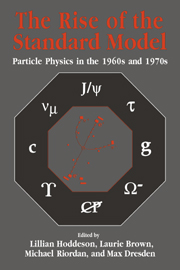Book contents
- Frontmatter
- Contents
- Contributors
- Editors' Acknowledgments
- Photographs of the Symposium
- Abbreviations and Acronyms
- Mathematical Notation
- Part One Introduction
- Part Two Quarks and Leptons
- Part Three Toward Gauge Theories
- Part Four Accelerators, Detectors, and Laboratories
- Part Five Electroweak Unification
- 23 The First Gauge Theory of the Weak Interactions
- 24 The Early History of High-Energy Neutrino Physics
- 25 Gargamelle and the Discovery of Neutral Currents
- 26 What a Fourth Quark Can Do
- 27 Weak-Electromagnetic Interference in Polarized Electron–Deuteron Scattering
- 28 Panel Session: Spontaneous Breaking of Symmetry
- Part Six The Discovery of Quarks and Gluons
- Part Seven Personal Overviews
- Index
26 - What a Fourth Quark Can Do
Published online by Cambridge University Press: 03 February 2010
- Frontmatter
- Contents
- Contributors
- Editors' Acknowledgments
- Photographs of the Symposium
- Abbreviations and Acronyms
- Mathematical Notation
- Part One Introduction
- Part Two Quarks and Leptons
- Part Three Toward Gauge Theories
- Part Four Accelerators, Detectors, and Laboratories
- Part Five Electroweak Unification
- 23 The First Gauge Theory of the Weak Interactions
- 24 The Early History of High-Energy Neutrino Physics
- 25 Gargamelle and the Discovery of Neutral Currents
- 26 What a Fourth Quark Can Do
- 27 Weak-Electromagnetic Interference in Polarized Electron–Deuteron Scattering
- 28 Panel Session: Spontaneous Breaking of Symmetry
- Part Six The Discovery of Quarks and Gluons
- Part Seven Personal Overviews
- Index
Summary
I do not claim any deep understanding of Finnegans Wake, but I believe that, had Murray Gell-Mann known the existence of more than three elementary constituents of hadronic matter, he would have chosen a different name. This paper is my recollection of the events that led to the conjecture about a lepton–hadron symmetric world. I want to warn the reader that, as I discovered experimentally, my memory is partial and selective. I would have been particularly worried by this discovery, had I not discovered at the same time that I share this human defect with practically all my colleagues. The difference is that most people are not aware of it, as I was not a couple of years ago, and, furthermore, different people forget or distort different things.
As far as I am concerned, the story begins around 1967 or 1968. I was on a postdoctoral fellowship at CERN coming from the University of Paris at Orsay, where I had done my thesis work under the direction of Philippe Meyer and Claude Bouchiat. I came to CERN in September 1966 and started working on current algebra, one of the most fashionable subjects at that time. Together with other postdocs and visitors, we formed a band of joyful youngsters, enjoying tremendously both physics and skiing, mountaineering, eating, drinking, and so on. We were not doing much in terms of physics, but as David Sutherland, a member of the band, put it, we were doing it in great style.
- Type
- Chapter
- Information
- The Rise of the Standard ModelA History of Particle Physics from 1964 to 1979, pp. 447 - 458Publisher: Cambridge University PressPrint publication year: 1997



